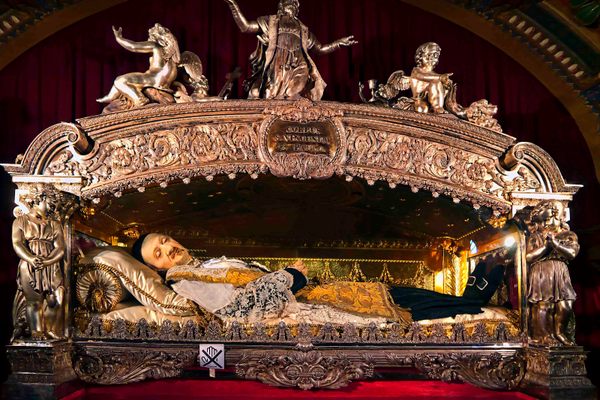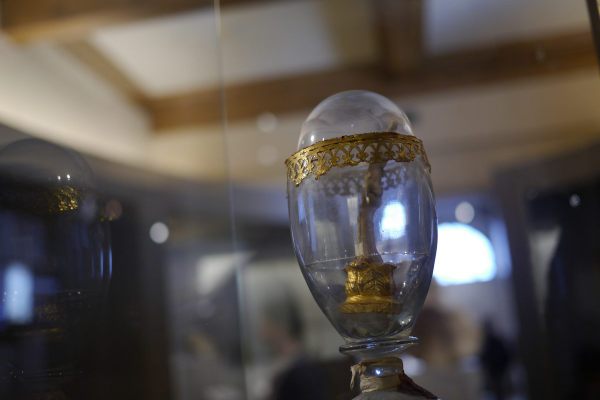The Cadaver Synod: When a Pope’s Corpse Was Put on Trial
Basilica of St. John Lateran (via Wikimedia)
Roman churches usually aren’t shy about their macabre histories. At Santa Maria dell’Orazione e Morte a nun will be happy to let you photograph their crypt of abandoned bodies in exchange for a small donation. At Santa Prassede a sacristan will give you a pamphlet and helpfully point out the well where St. Praxedis and St. Pudentiana poured the blood that seeped out of the three thousand bodies of martyrs they were hiding. At the famous Capuchin crypt you can even buy postcards of the mummified monks to send to dear friends or enemies.
But if you go to the Basilica San Giovanni Laterano looking for such morbid attractions, you’ll find you’re on your own. What happened there over one thousand years ago is still too horrible to speak of. This is the church where Pope Stephen VI put the rotting corpse of Pope Formosus on trial in January of 897.
The trial was called the Cadaver Synod or Synodus Horrenda (since everything is more colorful in Latin). It ushered in one of the most corrupt eras in the history of the papacy, a time that’s now referred to in all seriousness as the pornocracy.
Basilica San Giovanni Laterano (photograph by Rafel Miro)
To understand what happened to Pope Formosus’s unfortunate corpse, you have to understand that the world around him was falling apart. The western empire Charlemagne had united had since crumbled away into smaller and smaller factions. Little fiefdoms were eyeing Rome’s treasures and demanding protection money while the city was still smarting from the Saracen sack of 846. Rifts formed within the church as the men who aspired to be pope found they needed the additional strength of one of the many secular leaders to achieve it.
The story of the corpse trial actually starts during the reign of Pope John VIII. At this time, Formosus was bishop of Porto (the Roman suburb, not the city in Portugal). He was also a successful missionary, known for spreading Catholicism throughout the Bulgar kingdom. But he might have been a little too good at his job. Pope John VIII turned on Formosus and accused him of violating a law that prevented bishops from ruling over more than one place at a time — a law that was supposed to prevent bishops from building up their own little fiefdoms. And perhaps more tellingly, John accused Formosus of violating a recently passed law that forbid openly aspiring to the papacy. Formosus was getting a little too close for comfort, so John had him excommunicated.
Detail of the Basilica San Giovanni Laterano (photograph by Rafel Miro)
As it turned out, John’s paranoia was justified. He was the first pope to be murdered by his own people. At first he was poisoned, but the poisoner lost patience waiting for the potion to take effect and bashed John’s head in with a hammer. After John’s death the papacy had such a high turnover rate, it’s a wonder anyone wanted the job at all. Marinus I succeed John and re-instated Formosus as bishop. The following year Pope St. Adrian III succeeded Marinus, but barely lasted a year before being assassinated himself. Pope Stephen V followed shortly thereafter.
Finally in 891, it was Formosus’ turn. He managed to hold on to the papacy for five turbulent years before dying of a stroke. His successor, Boniface VI, was elected quickly to squelch riots, but he was an odd choice — he had been defrocked twice for “immoral conduct.” He only ruled for 15 days before he died of either gout or poisoning (again).
Next up was Pope Stephen VI. Less than a year into his papacy, he gave the order to dig up Formosus and force his corpse to stand trial for crimes Pope John VIII had excommunicated him for: seeking the papacy and ruling over more than one place a time as bishop.
Now Stephen VI’s reason for desecrating this poor corpse could have been to shore up some political alliances with a faction that hated Formosus, but more than likely it was to cover for the fact that Stephen was guilty of the exact same things he was accusing Formosus of. Formosus had made Stephen bishop, and Stephen had become bishop of Rome (a title that comes with the papacy) while he still held that post. But if Formosus could be found guilty of that same crime (being a simultaneous bishop of two places), his actions would be null and Stephen wouldn’t have been a bishop when he was elected pope. Stephen also might have been completely insane.
Jean-Paul Laurens, “Pope Formosus and Stephen VI - The Cadaver Synod” (1870) (via Musée des Beaux-Arts de Nantes)
So the corpse of Formosus was dragged out, dressed in papal robes, and propped up in a chair at San Giovanni Laterano. Ironically, poor Formosus’s name means “good looking” though by then he was a horrific sight. A deacon was appointed to speak for him, but predictably didn’t say much while Stephen screamed at the corpse. At one point in the trial an earthquake shook the basilica, damaging part of it. But even in the face of this ominous sign, Formosus was found guilty on all counts, stripped of his vestments, and had the three fingers he used for blessing on his right hand chopped off.
Stephen had him buried on an obscure plot of land, but then, thinking better of it, had him dug up one more time and tossed in the Tiber. At this point the people of Rome had just about enough of Stephen and his corpse trial. A mob threw him in prison where he was strangled in his cell. Later that year, San Giovanni Laterano was nearly destroyed by a fire as if to rid itself of the whole nasty business.
The next pope, Pope Romanus, annulled all the actions of Stephen VI, but was overthrown in less than a year. His successor, Pope Theodore II, was only pope for 20 days, yet managed to recover the body of Formosus. His successor, John IX oversaw Formosus’s reburial in St. Peter’s Cathedral. Today, there is still a monument that lists the names of popes buried there. There, you can see Formosus’ name carved in stone- one of the last vestiges of the Cadaver Synod.
List of popes buried in St. Peter’s Basilica, includingFormosus (via Wikimedia)
Read more about the wandering body parts of the holy dead at Elizabeth Harper’s All the Saints You Should Know.
Sources for this article:
The Bad Popes, E.R. Chamberlin
Keepers of the Keys of Heaven: A History of the Papacy, Roger Collins
The Ring and the Book, Robert Browning
Morbid Mondays highlight macabre stories from around the world and through time, indulging in our morbid curiosity for stories from history’s darkest corners. Read more Morbid Mondays>








Follow us on Twitter to get the latest on the world's hidden wonders.
Like us on Facebook to get the latest on the world's hidden wonders.
Follow us on Twitter Like us on Facebook